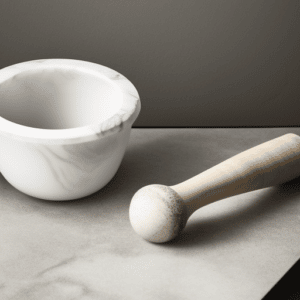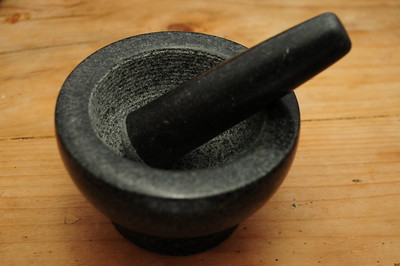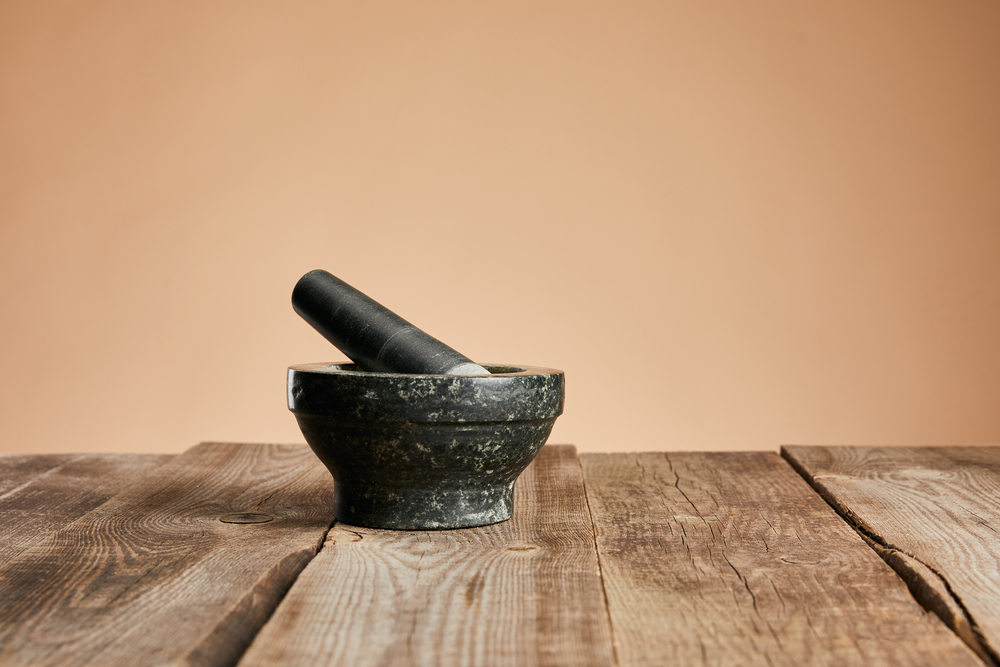Straightforward are terms that best describe a mortar and pestle. You can use these easy-to-use kitchen tools to grind herbs and spices for your cooking needs. They usually come in a pair — the mortar is a heavy-bottomed bowl, while the pestle is a heavy and elongated tool used for grinding. Note that the end of a pestle can either be flat or round.
That said, it’s worth mentioning that you should always give this unique kitchen appliance some TLC as it helps elongate its life. Well, if you’re wondering how to maintain your mortar and pestle properly, then you’re in the right place. More specifically, in this piece, we will look at how to clean a mortar and pestle. Read on!
Cleaning a Mortar and Pestle: The Go-to Method
Step 1: Rinsing With Warm Water
After using your mortar and pestle, remove any ground residue as much as possible. Then rinse your mortar and pestle with plenty of water, as this helps maximise the efficiency of this step.
Step 2: Adding Uncooked White Rice
Once you’re done removing all the food debris, pour some dry rice into the mortar. Note that it’s always advisable to use dry white rice that will act as an abrasive sponge for this step.
Step 3: Grinding the Rice to Powder
Once you have added a small handful of dry rice into the bowl, it’s time to grind it to powder. Slowly apply elbow grease in a timely manner. The ground rice will act as an abrasive that will help scrape off any residue left. Also, it will work as an absorbing agent and remove any oily ingredients and liquid remnants from the mortar and pestle itself.
Step 4: Rinsing
Once you’re done grinding your rice, it’s time to dump it out and rinse both your mortar and pestle.
Using warm water, thoroughly rinse both the mortar and pestle. When done, allow them to air dry and store them away safely.
Note: if you own a wooden mortar and pestle, you should always season it using food-grade mineral oil that is tasteless and safe for consumption. Remember you should season them once they are both dry, as this will help prevent wrapping and cracking caused by water loss.
Can I Use Olive Oil to Season?
Yes. However, note that this only applies to wood mortar and pestle. If you prefer using any food-grade oil, here are a few points you should always keep in mind.
- Not all food-grade oils are flavourless.
- Various oils have different shelf lives.
Different Types of Mortar and Pestles
There are different mortar and pestles available on the market, and they all come with various cleaning requirements. They typically include glass, cast iron, granite, and marble, but you could also find volcanic rock mortar and pestles. Let’s look at how to clean different mortars and pestles made of various materials.
How to Clean a Granite Mortar and Pestle
Granite mortars and pestles are made using reliable material that makes grinding spices and other ingredients a walk in the park. They are popular in Thailand and India for grinding spices and pastes for various meals.
When it comes to cleaning, rinse the mortar and pestle using water immediately once you’re done using it since granite is prone to staining when exposed to acidic and oily foods. Next, wash the granite mortar and pestle using warm water, a clean dishrag and mild dishwashing soap.
It’s always best to use unscented dish soap because it won’t leave any perfume residue on the mortar and pestle that can be transferred to food. Moreover, avoid, if you can, using an abrasive dish sponge to remove any stuck-on food residue. Rinse them thoroughly using warm water to remove any soapy residue. Using a clean cloth, dry both the mortar and pestle, as this will help prevent any water stains from forming on the granite.
How to Clean a Marble Mortar and Pestle

Marble mortars and pestles are ideal for grinding wet, soft and dry ingredients. They are also generally considered long-lasting. Here is a simple method on how to clean a mortar and pestle made of marble.
Wipe food debris from the previous grinding using a clean paper towel. Ensure that you pay attention to any carved nooks and crannies on the pestle’s handle if there are any. Treat any coloured stains on your mortar and pestle by dabbing them with a paper towel soaked in vinegar or lemon juice. However, ensure that the acidic liquid doesn’t sit too long on the stain.
Then squirt some mild dish soap on a washcloth and gently smear it all over the mortar and pestle. When done, rinse them with warm water thoroughly to remove any soap residue. Dry the mortar and pestle using a paper towel and store them away.
How to Clean Stone Mortars and Pestles
Stone mortars and pestles are also prone to staining when exposed to oily or acidic ingredients. You must always rinse them with warm water after being used to avoid unnecessary staining. Here is another tip on how to clean a mortar and pestle made with stone if you don’t have any white rice available.
When done using the stone mortar and pestle, rinse them thoroughly with water while cleaning the debris at the bottom of the bowl and pestle with the help of your hands. When done, pour some mild soap on a soft sponge and use it to clean both the mortar and pestle, then rinse it thoroughly with warm water. Dry it using a dry cloth to prevent any water stains from forming on the mortar and pestle. Optionally you can allow them to air dry.
If you have some uncooked white rice, we suggest using this method to clean your stone mortar and pestle. Add two tablespoons of rice and grind it until the colour of the rice turns dark, then discard it always. Repeat this process at least until the colour of the ground rice remains white—wipe both your mortar and pestle using a dry towel and store it away.
As stated above, rice is an absorbent and slightly abrasive agent that should help remove any oily remnants and old spices or herbs from your mortar and pestle much easier.
How to Clean a Ceramic Mortar and Pestle

Ceramic mortars and pestles come with a surface that makes them ideal for crushing ingredients to powder. However, they are more delicate than stone ones and tend to stain and become brittle if they don’t receive proper TLC.
When cleaning ceramic mortars and pestles, it’s always advisable to use warm water and mild dish soap. After you’re done using them, dry them with a clean cloth before storing them away.
Note: Avoid using excessive pressure when cleaning a ceramic mortar and pestle.
Clean Your Mortar and Pestle With the Right Method
That’s it on how to clean a mortar and pestle. We hope this article will help you out when your mortar and pestle need a thorough cleaning after preparing your curry: remember that uncooked white rice is a game changer!
Ensure also to give your mortar and pestle some TLC from time to time. Avoid using soap if yours is made of porous materials, and never clean them inside a dishwasher.

